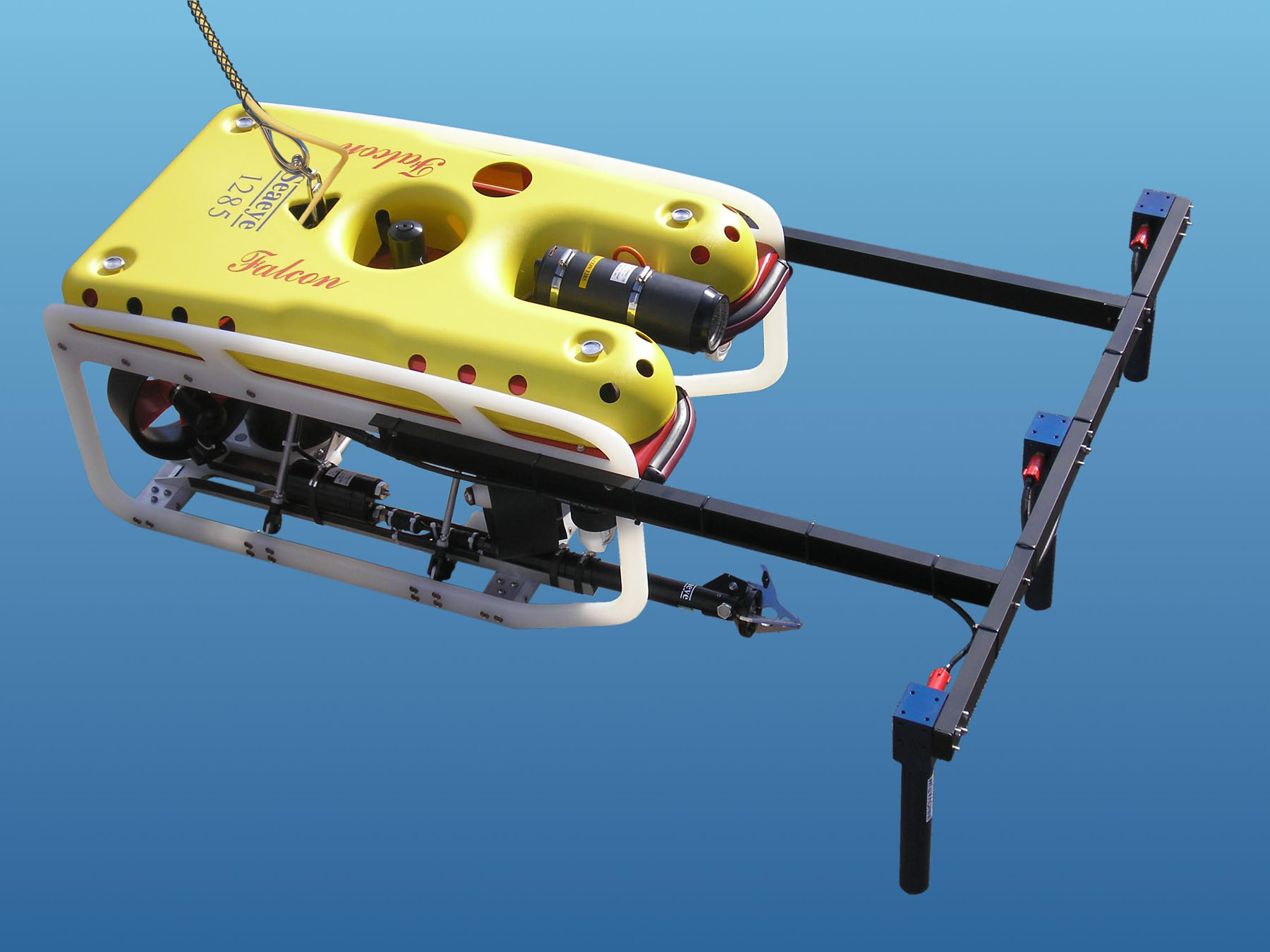With a conventional system costing up to £500,000, this innovative solution costs just £150,000.
Cleverly, Submagnetix, a division of Innovatum, has integrated the compact Saab Seaeye Falcon ROV with their system, to create a small and rapidly mobilised package that can be deployed from a small vessel and survey all types of inshore and coastal submarine cables and pipelines.
As the only survey solution of its kind in the world, Innovatum’s SMARTRAK 9, can sense cables carrying either AC or DC current, and cables with no current or signal at all. It also senses steel pipelines.

Falcon fitted with Smartrak.
The system includes fitting the Falcon ROV with a Tritech Super SeaKing profiler system to provide high quality cross-sectional profile data of the seabed and to provide underwater ROV position data, a Tritech Micron-Nav USBL navigation transducer along with pitch and roll sensing, an accurate flux gate compass, a high accuracy altimeter and a pressure sensor for depth.
Surface equipment consists of three small rack units – one for the ROV controller, the other for the cable tracker and acoustics unit, and another for the surface navigation and video and event logger.
Only two people per shift are needed to launch and operate the system, with one controlling the ROV and the other the survey equipment.
Although the system can use ROVs from different manufacturers, the Falcon is a trusted design with over 200 in use around the globe. Its success has come from trusted design with over 200 in use around the globe. Its success has come from being a powerful free-swimming ROV that is small enough to be manhandled, yet is packed with technological innovations developed from Saab Seaeye's wide range of observation and work-class vehicles.
Users in all industries have been attracted by the Falcon's reputation for reliability and unequalled stability in strong cross-currents. They also value its robust design and intelligent 'plug-and-go' electronics that enable different tooling to be added and changed as needed.
For survey work, the Falcon has a low electrical and acoustic noise signature for optimum survey sensor data.
The SUBMAGNETIX division of Innovatum, was established to carry out submarine cable surveys in shallow water depths from the beach down to 50 metres. This is the typical scenario for offshore windfarms, interconnector power cables and coastal communications cables.
Comprehensive reports and charts are created, showing accurate cable route and depth of bury along the route. These are required by installation contractors, owners and regulatory authorities, to ensure that the cable is properly buried and not in danger of being exposed to damage.
The cable and pipeline tracking system uses three different methods to acquire target data.
Passive Magnetic Mode
This is used for pipeline survey work using the natural field of steel pipes, and for cable survey, either by the weak natural fields of the cable or the stronger fields developed by specially magnetising the cable armour or strength member prior to cable lay.
An array of vertically mounted magnetic gradiometers is used to collect magnetic field gradient information. The change in field gradient near to the target is caused by both the intrinsic magnetism of the target and the effect of the permeable material in the target ‘bending’ the magnetic field of the earth. The local terrestrial field effects are mathematically removed and the field gradients resolved to produce a two-dimensional target position. A tri-axial fluxgate sensor, which may be part of one of the gradiometer instruments, is used to provide heading information and this, combined with the known heading of the target, is used to adjust the calculations for angular offsets and to produce the tracking display.
Active DC Mode
This option if used for tracking live HVDC cables, and trans-oceanic telecommunication cables.
It does this by tracking the magnetic fields from the repeater drive currents. A ‘true North Seeking Gyro’ is required to obtain accurate heading information.
This is similar to passive magnetic mode, except the field gradients are produced by the DC current flowing in the cable or pipe. Fields produced by a DC current in this manner are at right angles to the fields produced by the magnetism of a pipeline. Range is dependent on the current in the target, varying from < 1m at 0.5A to > 10m at 500A.
Active AC Mode
This method of tracking is primarily used for locating, tracking and surveying cables.
An array of up to six tri-axial flux gates is used to sense the alternating magnetic field produced by a unidirectional AC current flowing in the target cable or pipeline. This current flow must have a remote return path. As the frequency of the AC may be accurately controlled, and the magnetic field signals may be accurately filtered, highly accurate data may be produced. Target direction data is also produced, allowing accurate alignment of cable maintenance vehicles with the target cable.
Innovatum see their system having a great appeal to small survey companies, electric companies and those carrying out hydrographic studies. It means they no longer need to use a large, bulky and expensive, power-hungry survey system, say the company.
Innovatum is the world's leading manufacturer of magnetic tools for the location, tracking and survey of submarine pipelines and cables. It has over thirty years continuous development experience in the field and its systems are sold world-wide.